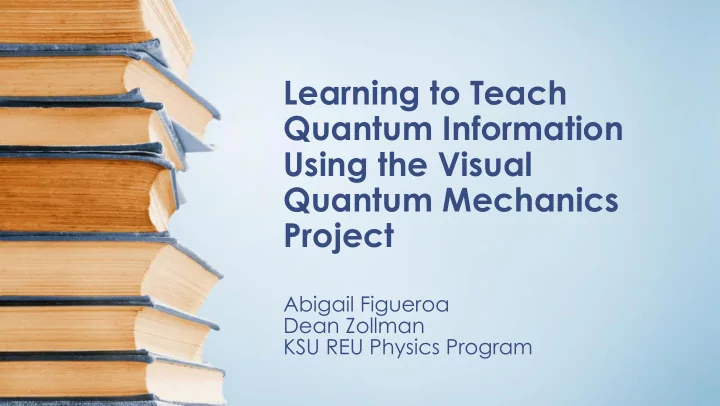

Learning to Teach Quantum Information Using the Visual Quantum Mechanics Project Abigail Figueroa Dean Zollman KSU REU Physics Program
Cryptography How does it work? Alice Sender (Alice) • 1+1 =0 11001 Receiver (Bob) • ? Secret Key – random • sequence of 0s and 1s, where each is a bit Bitwise addition 01001 • Ciphertext • Bob 10000 10000 + 01001=11001 Quick maths! 2
Simulation by Antje Kohnle and Aluna Rizzoli 2017 Learning about the key generating using simulation https://www.st-andrews.ac.uk/physics/quvis/simulations_html5/sims/BB84_photons/BB84_photons.html 3
Visual Quantum Mechanics (VQM) Instructional materials intended to help understand quantum conceptually for students with minimal physics and math background The Emission module in the Spectroscopy Lab Suite . Students drag the light source on the right to the power supply. Then they build an energy level model of the atom to match the observed 4 spectrum. [2]
Example of A Module 5
Concept Map 6
Concept Map 7
Process 8
Current Objectives Concept Map Objectives Importance of securing messages Understand how to create a key Need Same basis The need for random distribution Using concept map to highlight the main points in the objectives 9
Module Attempt: the challenging Short introduction about cryptography historically, • part making the reference of the German Enigma Reminders of photon polarization and bases • A general layout of the simulation • Focus on how a key is made using Fixed Bases • the use of questions • an attempted review • 10
Research Questions Can we actually teach quantum information in an introductory level? • How can we incorporate previous lessons into this new module? • o How do we word the lesson with language accessible to the students? o What questions can we generate? What other resources can we add in this module? • o What videos and simulations are helpful to enhance student understanding? 11
Next Steps Short term Rework and Revise current • work Considering adding another • module on random bases Adding “pre” modules such • as photon polarization Long term Testing the module on • students 12
Acknowledgements • Special thanks to: – Dr. Dean Zollman – Raiya Ebini – KSU PER – Kansas State Physics REU program – Physics group Supported by the US National Science Foundation 13
References [1] D. Zollman, (AAPT, 2016). [2] D. A. Zollman, N. S. Rebello and K. Hogg, American Journal of Physics 70 (3), 252-259 (2002). [3] A. Kohnle and A. Rizzoli, European Journal of Physics 38 (3), 035403 (2017).
Recommend
More recommend